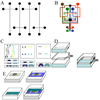Phase-changing sacrificial layers in microfluidic devices: adding another dimension to separations
- PMID: 18836705
- PMCID: PMC2605771
- DOI: 10.1007/s00216-008-2408-y
Phase-changing sacrificial layers in microfluidic devices: adding another dimension to separations
Abstract
The use of polymers in microchip fabrication affords new opportunities for the development of powerful, miniaturized separation techniques. One method in particular, the use of phase-changing sacrificial layers, allows for simplified designs and many additional features to the now standard fabrication of microchips. With the possibility of adding a third dimension to the design of separation devices, various means of enhancing analysis now become possible. The application of phase-changing sacrificial layers in microchip analysis systems is discussed, both in terms of current uses and future possibilities.
Figures




Similar articles
-
Phase-changing sacrificial materials for interfacing microfluidics with ion-permeable membranes to create on-chip preconcentrators and electric field gradient focusing microchips.Anal Chem. 2006 Apr 15;78(8):2565-70. doi: 10.1021/ac0521394. Anal Chem. 2006. PMID: 16615765
-
Phase-changing sacrificial materials for solvent bonding of high-performance polymeric capillary electrophoresis microchips.Anal Chem. 2005 Jun 1;77(11):3536-41. doi: 10.1021/ac0501083. Anal Chem. 2005. PMID: 15924386
-
Sacrificial layer microfluidic device fabrication methods.Electrophoresis. 2006 Dec;27(24):4888-95. doi: 10.1002/elps.200600399. Electrophoresis. 2006. PMID: 17117379 Free PMC article. Review.
-
Phase-changing sacrificial layer fabrication of multilayer polymer microfluidic devices.Anal Chem. 2008 Jan 1;80(1):333-9. doi: 10.1021/ac7017475. Epub 2007 Nov 22. Anal Chem. 2008. PMID: 18031061 Free PMC article.
-
Monolithic media in microfluidic devices for proteomics.Electrophoresis. 2006 Sep;27(18):3547-58. doi: 10.1002/elps.200600058. Electrophoresis. 2006. PMID: 16927347 Review.
References
Publication types
MeSH terms
Substances
Grants and funding
LinkOut - more resources
Full Text Sources

